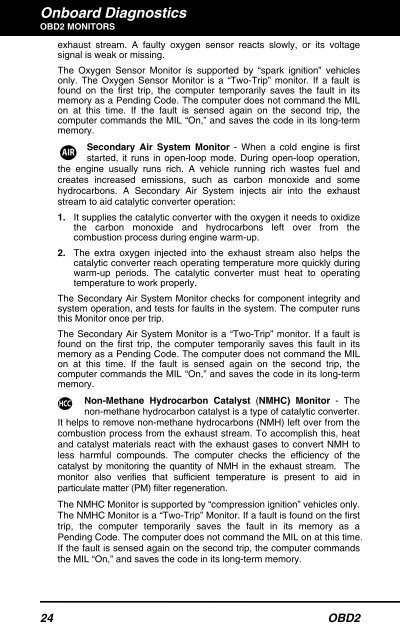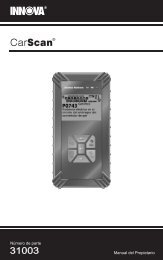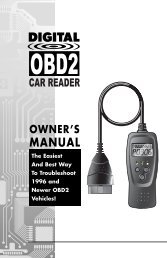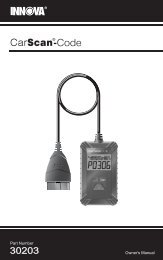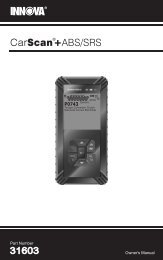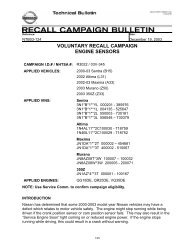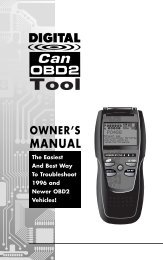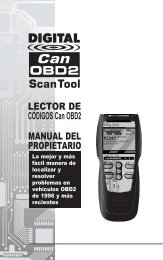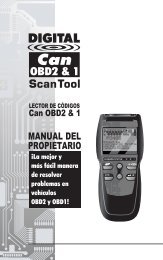Untitled - Innova
Untitled - Innova
Untitled - Innova
Create successful ePaper yourself
Turn your PDF publications into a flip-book with our unique Google optimized e-Paper software.
Onboard Diagnostics<br />
OBD2 MONITORS<br />
exhaust stream. A faulty oxygen sensor reacts slowly, or its voltage<br />
signal is weak or missing.<br />
The Oxygen Sensor Monitor is supported by “spark ignition” vehicles<br />
only. The Oxygen Sensor Monitor is a “Two-Trip” monitor. If a fault is<br />
found on the first trip, the computer temporarily saves the fault in its<br />
memory as a Pending Code. The computer does not command the MIL<br />
on at this time. If the fault is sensed again on the second trip, the<br />
computer commands the MIL “On,” and saves the code in its long-term<br />
memory.<br />
Secondary Air System Monitor - When a cold engine is first<br />
started, it runs in open-loop mode. During open-loop operation,<br />
the engine usually runs rich. A vehicle running rich wastes fuel and<br />
creates increased emissions, such as carbon monoxide and some<br />
hydrocarbons. A Secondary Air System injects air into the exhaust<br />
stream to aid catalytic converter operation:<br />
1. It supplies the catalytic converter with the oxygen it needs to oxidize<br />
the carbon monoxide and hydrocarbons left over from the<br />
combustion process during engine warm-up.<br />
2. The extra oxygen injected into the exhaust stream also helps the<br />
catalytic converter reach operating temperature more quickly during<br />
warm-up periods. The catalytic converter must heat to operating<br />
temperature to work properly.<br />
The Secondary Air System Monitor checks for component integrity and<br />
system operation, and tests for faults in the system. The computer runs<br />
this Monitor once per trip.<br />
The Secondary Air System Monitor is a “Two-Trip” monitor. If a fault is<br />
found on the first trip, the computer temporarily saves this fault in its<br />
memory as a Pending Code. The computer does not command the MIL<br />
on at this time. If the fault is sensed again on the second trip, the<br />
computer commands the MIL “On,” and saves the code in its long-term<br />
memory.<br />
Non-Methane Hydrocarbon Catalyst (NMHC) Monitor - The<br />
non-methane hydrocarbon catalyst is a type of catalytic converter.<br />
It helps to remove non-methane hydrocarbons (NMH) left over from the<br />
combustion process from the exhaust stream. To accomplish this, heat<br />
and catalyst materials react with the exhaust gases to convert NMH to<br />
less harmful compounds. The computer checks the efficiency of the<br />
catalyst by monitoring the quantity of NMH in the exhaust stream. The<br />
monitor also verifies that sufficient temperature is present to aid in<br />
particulate matter (PM) filter regeneration.<br />
The NMHC Monitor is supported by “compression ignition” vehicles only.<br />
The NMHC Monitor is a “Two-Trip” Monitor. If a fault is found on the first<br />
trip, the computer temporarily saves the fault in its memory as a<br />
Pending Code. The computer does not command the MIL on at this time.<br />
If the fault is sensed again on the second trip, the computer commands<br />
the MIL “On,” and saves the code in its long-term memory.<br />
24 OBD2


